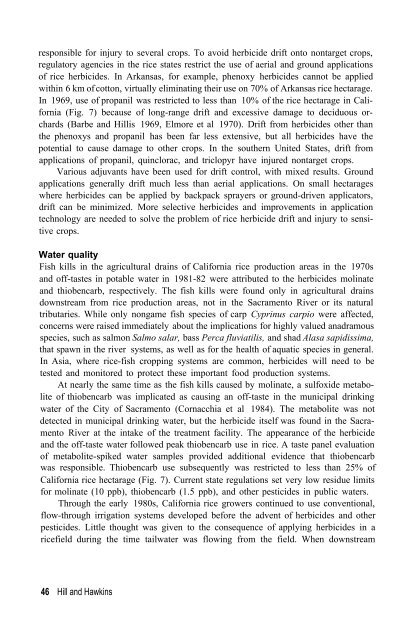HERBICIDES in Asian rice - IRRI books - International Rice ...
HERBICIDES in Asian rice - IRRI books - International Rice ...
HERBICIDES in Asian rice - IRRI books - International Rice ...
You also want an ePaper? Increase the reach of your titles
YUMPU automatically turns print PDFs into web optimized ePapers that Google loves.
esponsible for <strong>in</strong>jury to several crops. To avoid herbicide drift onto nontarget crops,<br />
regulatory agencies <strong>in</strong> the <strong>rice</strong> states restrict the use of aerial and ground applications<br />
of <strong>rice</strong> herbicides. In Arkansas, for example, phenoxy herbicides cannot be applied<br />
with<strong>in</strong> 6 km of cotton, virtually elim<strong>in</strong>at<strong>in</strong>g their use on 70% of Arkansas <strong>rice</strong> hectarage.<br />
In 1969, use of propanil was restricted to less than 10% of the <strong>rice</strong> hectarage <strong>in</strong> California<br />
(Fig. 7) because of long-range drift and excessive damage to deciduous orchards<br />
(Barbe and Hillis 1969, Elmore et al 1970). Drift from herbicides other than<br />
the phenoxys and propanil has been far less extensive, but all herbicides have the<br />
potential to cause damage to other crops. In the southern United States, drift from<br />
applications of propanil, qu<strong>in</strong>clorac, and triclopyr have <strong>in</strong>jured nontarget crops.<br />
Various adjuvants have been used for drift control, with mixed results. Ground<br />
applications generally drift much less than aerial applications. On small hectarages<br />
where herbicides can be applied by backpack sprayers or ground-driven applicators,<br />
drift can be m<strong>in</strong>imized. More selective herbicides and improvements <strong>in</strong> application<br />
technology are needed to solve the problem of <strong>rice</strong> herbicide drift and <strong>in</strong>jury to sensitive<br />
crops.<br />
Water quality<br />
Fish kills <strong>in</strong> the agricultural dra<strong>in</strong>s of California <strong>rice</strong> production areas <strong>in</strong> the 1970s<br />
and off-tastes <strong>in</strong> potable water <strong>in</strong> 1981-82 were attributed to the herbicides mol<strong>in</strong>ate<br />
and thiobencarb, respectively. The fish kills were found only <strong>in</strong> agricultural dra<strong>in</strong>s<br />
downstream from <strong>rice</strong> production areas, not <strong>in</strong> the Sacramento River or its natural<br />
tributaries. While only nongame fish species of carp Cypr<strong>in</strong>us carpio were affected,<br />
concerns were raised immediately about the implications for highly valued anadramous<br />
species, such as salmon Salmo salar, bass Perca fluviatilis, and shad Alasa sapidissima,<br />
that spawn <strong>in</strong> the river systems, as well as for the health of aquatic species <strong>in</strong> general.<br />
In Asia, where <strong>rice</strong>-fish cropp<strong>in</strong>g systems are common, herbicides will need to be<br />
tested and monitored to protect these important food production systems.<br />
At nearly the same time as the fish kills caused by mol<strong>in</strong>ate, a sulfoxide metabolite<br />
of thiobencarb was implicated as caus<strong>in</strong>g an off-taste <strong>in</strong> the municipal dr<strong>in</strong>k<strong>in</strong>g<br />
water of the City of Sacramento (Cornacchia et al 1984). The metabolite was not<br />
detected <strong>in</strong> municipal dr<strong>in</strong>k<strong>in</strong>g water, but the herbicide itself was found <strong>in</strong> the Sacramento<br />
River at the <strong>in</strong>take of the treatment facility. The appearance of the herbicide<br />
and the off-taste water followed peak thiobencarb use <strong>in</strong> <strong>rice</strong>. A taste panel evaluation<br />
of metabolite-spiked water samples provided additional evidence that thiobencarb<br />
was responsible. Thiobencarb use subsequently was restricted to less than 25% of<br />
California <strong>rice</strong> hectarage (Fig. 7). Current state regulations set very low residue limits<br />
for mol<strong>in</strong>ate (10 ppb), thiobencarb (1.5 ppb), and other pesticides <strong>in</strong> public waters.<br />
Through the early 1980s, California <strong>rice</strong> growers cont<strong>in</strong>ued to use conventional,<br />
flow-through irrigation systems developed before the advent of herbicides and other<br />
pesticides. Little thought was given to the consequence of apply<strong>in</strong>g herbicides <strong>in</strong> a<br />
<strong>rice</strong>field dur<strong>in</strong>g the time tailwater was flow<strong>in</strong>g from the field. When downstream<br />
46 Hill and Hawk<strong>in</strong>s

















